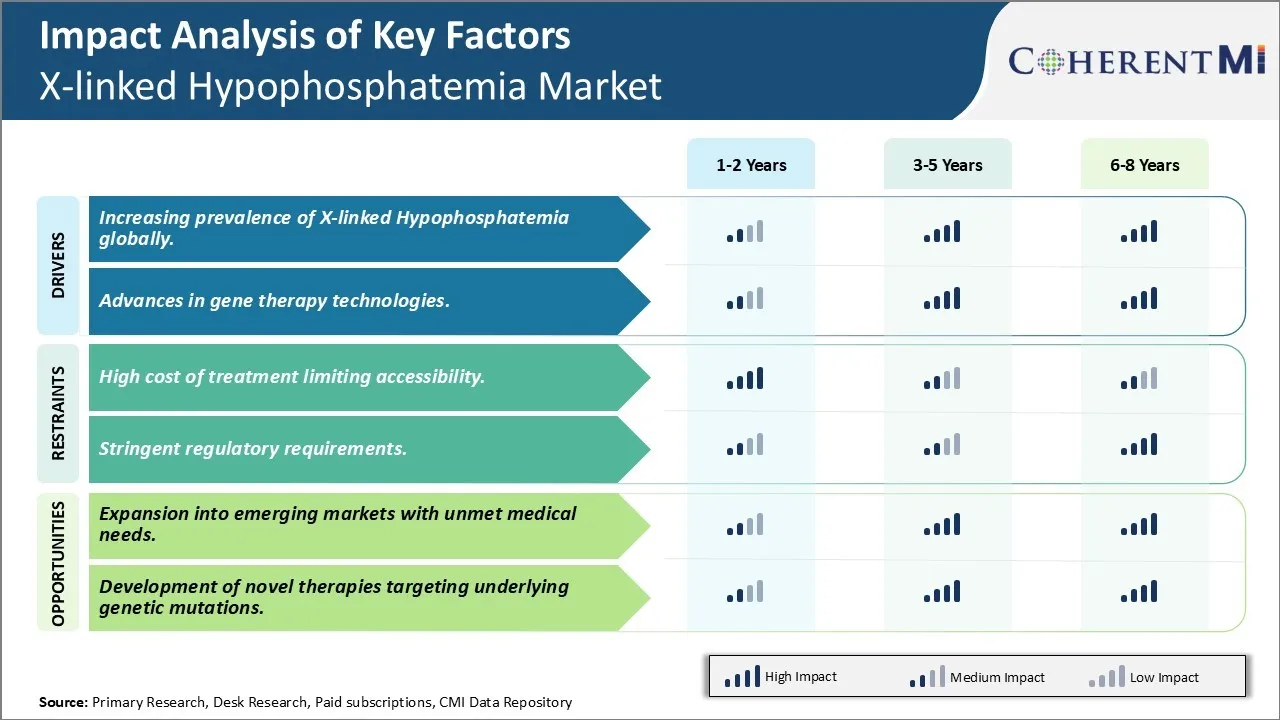X-linked Hypophosphatemia Market Trends
Market Driver - Increasing prevalence of X-linked hypophosphatemia globally
One of the major factors driving the growth of the X-linked Hypophosphatemia market is the increasing prevalence of the condition worldwide. X-linked Hypophosphatemia is a genetic disorder characterized by abnormally low levels of phosphorus in the blood and bones. The exact prevalence of XLH is unknown, however estimates suggest it affects approximately 1 in 20,000 individuals globally. Some studies have found a higher prevalence in certain populations such as 1 in 12,000 live male births in Denmark.
While the cause of XLH is genetic in nature, linked to mutations on chromosome X, environmental and lifestyle factors are believed to play a role in increasing the risks as well. With changing dietary patterns, more sedentary lifestyles and urbanization on the rise across both developing and developed countries, risks of metabolic conditions like XLH have been escalating. Additionally, advanced screening and diagnostic capabilities have enabled more cases to be detected now than ever before. Growing health awareness combined with better access to healthcare in many developing nations is also contributing to the improved reporting of XLH cases worldwide.
All of these factors indicate the patient pool for XLH is expanding rapidly. As a result, demand for effective treatment options and management of the condition is surging. Traditional therapies like phosphate and vitamin D supplements have been the mainstay of XLH treatment but newer biologic therapies targeting the underlying cause are gaining popularity. Their ability to more comprehensively address symptoms and long term complications of XLH makes them an attractive proposition for both patients and physicians alike, driving higher adoption and uptake. The growing prevalence and identification of more XLH cases presents a sizable opportunity for drugs and therapies in this market.
Market Driver - Advances in gene therapy technologies
Another key growth driver for the X-linked hypophosphatemia market has been the significant advances in gene therapy technologies in recent years. Gene therapy involves replacing, manipulating or supplementing nonfunctional genes in a patient's cells and tissues to treat or cure genetic disorders. For XLH, which arises due to mutations in the PHEX gene located on the X chromosome, gene therapy holds promising potential.
Over the past decade, there have been major breakthroughs in the development of various gene therapy delivery systems like viral vectors, non-viral gene transfer methods and gene editing tools like CRISPR that have enabled more targeted and effective genetic manipulation. Clinical trials on various monogenic diseases have proven gene therapies can provide long term therapeutic benefits with a single dose treatment versus the need for repeated drug administration in traditional therapies. This makes them highly appealing to patients coping with a lifelong condition like XLH.
Encouraged by these successes, efforts to develop gene therapies for XLH have intensified. Currently several companies have preclinical programs investigating the use of AAV vectors, lentiviral vectors and oligonucleotide approaches to replace the defective PHEX gene or compensate for its absence. With gene therapy now considered one of the most innovative areas in medicine, greater funding is also flowing into accelerating the research work. If clinical success can be achieved, it could potentially revolutionize XLH management by addressing the root cause in a onetime cure rather than symptom suppression as seen with current options. This promising avenue has become a major driver catapulting the XLH therapeutics field forward.

Market Challenge - High cost of treatment limiting accessibility
One of the major challenges faced by the X-linked Hypophosphatemia market is the high cost of treatment which severely limits accessibility to a large patient population. Treatment of XLH involves lifelong medication with expensive phosphate and vitamin D supplements which places a heavy financial burden on patients. The average annual cost of treatment in Western countries ranges between $5,000 to $10,000 per patient. This high cost is a major barrier for many patients, especially those located in less developed regions or without adequate health insurance. Many patients struggle to afford regular prescribed doses or are forced to ration their medication. This leads to suboptimal treatment outcomes and worsening of symptoms over time. The high costs also discourage pharmaceutical companies from investing in new drug development for this rare disease. Unless new policies are introduced to curb treatment expenses or provide subsidies, accessibility will remain extremely limited for a large number of underprivileged XLH patients globally.
Market Opportunity: Expansion into emerging markets with unmet medical needs
One key opportunity for players in the XLH market is the potential for expansion into emerging economies which have large patient populations with significant unmet medical needs. Many Asian and Latin American countries have a high prevalence of XLH due to genetic factors but lack proper diagnosis rates and access to treatment. This represents a large untapped market base. Pharmaceutical companies could look at obtaining regulatory approvals and establishing supply chains and distribution networks in these regions. Partnering with local healthcare providers and patient advocacy groups would help in screening, identification and enrollment of patients. Introducing more affordable generic formulations tailored for these markets also provides an opportunity to expand accessibility. With rising incomes and awareness, demand is expected to grow rapidly over the coming years. Companies addressing the treatment gap in emerging nations stand to benefit significantly from first-mover advantage in these expanding XLH markets of the future.